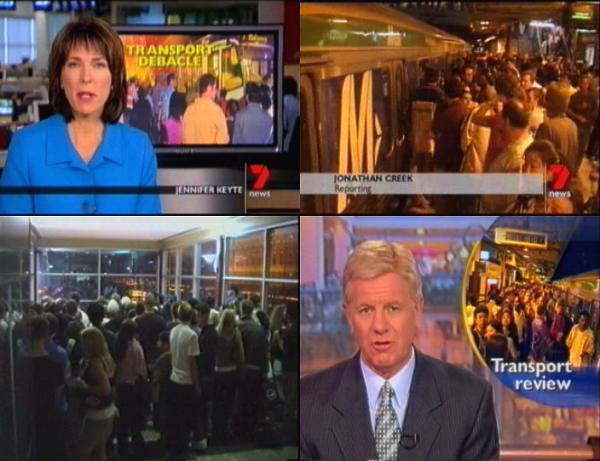…and how pictures make a story real.
If there was a Daniel FAQ, these questions would feature in it: Why are you involved in the Public Transport Users Association? What’s in it for you? And can I tell you about how late my train was this morning?
Perhaps another long rambling retrospective is in order.
Prehistory
When I was growing up, we didn’t have a car. The shopping was done with a shopping jeep at the local shops in Balaclava. Most of our friends lived in walking distance. My sister and I walked to school — something that is increasingly rare nowadays, as most parents are loathe to let primary school-aged kids walk the streets on their own. (Note, however, that we didn’t wear coal sacks, and didn’t trudge through the snow for three miles to get there.)
My dad was in the PTUA’s predecessor, the Train Travellers Association, and being a regular user of public transport, I showed an interest in my early teens, but then forgot about it for a while. I joined up again in my early twenties, during a period when I was a rabid anti-car-head. Oil was killing the planet, man. I didn’t have a driver’s licence, refused to get one or buy a car, and firmly believed in the ideal of sustainable transport.

The 1969 Melbourne freeway plan. Was your suburb was going to be bulldozed?
Why sustainable transport?
Eventually shaking off transport martyr status (there’s only so many times you can sit on a cold bench on a dark street corner waiting for a late tram) at the age of 27 I got a licence and a car. But I still believe firmly in sustainable transport. Why?
- I’ve got an interest in a few green issues, but it’s one of the most important ones in big cities.
- It’s one of a small number of elements that are critical to the liveability of our cities. Think about all the things that make Melbourne a good place to live in… the parks, the street cafes, the vibrant restaurant scene, the pleasant and safe(ish) walking environs, the clean(ish) air. All of these depend on being able to move people around the city and suburbs without flattening huge swathes of land for roads, and leaving our streets choking with fumes.
- Because it’s unhealthy to live your life not getting adequate exercise. Walking (including to the tram stop or the station) is some of the best exercise you can get, and costs nothing but a little time. Study after study laments growing problems with fitness and obesity in western society, due in no small amount to the fact that increasing numbers of people drive their cars everywhere.
- But people can’t do that unless there is adequate public transport. Fast, frequent, cheap, clean and safe. And while people in my suburb and some others get by, much of Melbourne has nothing usable.
Those are the main points for me, but some other very worthy reasons to support sustainable transport include:
- Think global, act local. Global warming continues to be a real problem, and while making Melbourne’s public transport better may not seem to affect other cities around the world, fact is others do look to Melbourne as something to aspire to in the transport field (hard to believe when you’re train’s late and crowded and sweaty, but true). Every improvement anywhere has a trickle-down affect as others try to copy.
- The coming shortage of oil is going to cause dire economic and social problems if we continue to be dependent on it.
- Social justice considerations. Is it fair that people in the poorest suburbs in the outer reaches of Melbourne have little cheap usable public transport at their disposal, and spend large (and increasing) amounts of their incomes trying to run cars?
- The budget for new freeways continues to burn up humungous amounts of money. Alternatives for moving people around are not only better for our city, they’re much cheaper, allowing those funds to be used for other important things such as schools and hospitals, and disabled lesbian outreach facilities. (Okay I may be stretching it a bit on that last one.)
- I like driving my car, but really, if you were designing a worldwide urban transport system today, there is no way you’d go for the one that nationwide killed thousands per year, polluted the air, was dependent on expensive fossil fuels provided by a virtual monopoly in the most unstable part of the world, and consumed up to half the available open space in cities. We need viable alternatives.
And so…
In the late-90s, I got roped into editing the PTUA’s newsletter, and subsequently joined the committee. Last year a number of key people stepped down or aside, and the question was: who would take over being the president, and doing the media work? In the absence of anybody else (and in particular anybody who like me works in the CBD and who wears a tie — both very handy things for TV media in particular), I stepped forward.
It’s a democratic organisation, and maybe I’ll get rolled at the next Annual General Meeting, but I’m enjoying it so far. I’ve enjoyed the challenge of learning how the media works. There’s some other elements involved too, but media is the main part of the role. And that’s what’s in it for me.
It’s worth noting that public transport advocacy is not about nagging people to use it. There’s a whole government department for that. Ultimately it’s a free country, and people have to make up their own minds. Advocacy is about fighting for better services: services that people want to use (at least some of the time), thus reducing the negative effects of car use in our cities.
The New Year’s Eve story
But, you ask, does it achieve anything? Does this kind of lobbying ever achieve a change for the better? Is it really worth it, shouting for the cause, if nothing ever happens?
Why yes it does. Here’s an example.
On New Year’s Eve 2002, thousands of people crowded into the city to watch the fireworks. Afterwards they tried to get home, as the government and transport operators had recommended, using public transport. But the services were woefully inadequate. There was chronic overcrowding, and many people left behind when trains and trams stopped. Peter, a PTUA committee member, observed this and registered his disgust privately in the following days. Big events attracting lots of people at one time are what public transport should do best. And they should make an effort to do it well, to attract new customers. Stuff-ups like that just discourage any occasional customers from ever coming back.
But almost nobody among the general public remembered what a disaster it had been. It didn’t make the media, because there were no pictures. Just as if it had never happened, in much the same way as Media Watch on Monday seemed to conclude about the Iraqi prisoner scandal: the lobby groups knew, but it wasn’t “news” until there were pictures.
In December 2003, we discovered they were planning much the same services for NYE 2003. We registered our concern, but were told “it’ll be fine”. So a couple of the guys did some comparisons of cities, and calculations comparing the expected crowd (300,000) to the capacity of the services out of the city after midnight (60,000). We put out a press release, and as it happened so did the Taxi Industry, taking the same view that more public transport was needed after midnight because 5,000 taxis simply can’t move 300,000 people. Both our efforts got some press and TV.
And on the night? Chris and Peter, our hardy volunteers, stepped forward to go out and observe, cameras in hand. Fine weather and the promise of spectacular fireworks brought the crowds in again. Just as happened the previous year, the result was that when the trains and trams shut down at 1:30, thousands remained stranded in the city. But this time, we had proof. Photos and video.
The media jumped on it the next morning. I’d had an early night, but the volunteers left voicemails to let me know what had happened, and I was able to tell a parade of calling journalists about what a disaster it had been. (Full points to Marita and Justine for their patience that morning.)
ABC radio did a talkback segment on it — at 8am, somewhat mistimed, since partiers would either still be partying or be asleep. One irritating woman rang up to proclaim that public transport didn’t exist anymore. This is what’s known by us who know about such things as irrelevant BS. “Public” refers to who uses it, not who owns it. In any case, the government still foots the bill, and of course it had nothing to do with the events at hand. But I digress.
Channel 7 grabbed the video footage (due to an oversight, exclusively… we’d have preferred it went to all channels), and ran it as their top story on the evening news:
The Herald-Sun ran it on their front cover the following day, complete with a doom-and-gloom black border, a huge “FIX THIS” heading, and two pages of photos inside, with a lengthy extract from the account from our web site printed as well.

The remaining TV stations ran the video on their news bulletins. The Acting Premier had initially denied anything had gone wrong, saying it all ran smoothly, but backed away from this when overwhelming evidence was all over the media.
The pictures made it fact
It had become fact. The pictures made it become fact. The NYE public transport debacle (as both channels 7 and 9 described it) became part of the collective memory of the population. A problem which had to be fixed.
When the new train and tram contracts were announced in February, they included all-night train services on New Years Eve. Trams weren’t included, and it’s only one night of the year, but it’s still a significant change. It was something they had previously told us they wouldn’t and couldn’t do. We proved it was necessary, and told the world, forcing them to back down. A win brought about by a handful of volunteers.
There’s still a long way to go in the campaign for better public transport, of course. But wins like that keep everybody enthused, and underline the point: if find something you believe in, and fight for it, you can make a difference.
Update June 2006: Added Channel 7 news video, via YouTube.

10 replies on “How I became a transport activist”
Daniel, I wholeheartedly agree that public transport is to be encouraged. I just want to quickly tell you about the trouble I’ve had trying to register my outrage at the use of the bike lane on Macaulay Rd, Kensington by drivers (and I am a driver too). It’s taken six months, two letters, phones calls to City of Mooney Valley, City of Melbourne (2 calls), the Victoria Police and RTA, to get somebody to listen to me. Hooray for the RTA, even though it wasn’t in their jurisdication they passed on my concerns to City of Melbourne. Lo and behold in last night’s mail I received an acknowledgement from City of Melbourne that they would police the traffic flow and use of the bicycle lane. This was after consistently denying that they had any responsibility to look into my complaint. No wonder we get disheartened. My victory was further enhanced by the presence of a motorcycle cop (hiding?) behind a parked car a couple of nights ago. I wonder how many smart assed drivers had to swerve back in to the “real” driving lane when they spotted the cop. I hope he booked dozens of them. To those who do choose to use the bike lane to zip ahead of the cars legally waiting to get to the lights, who do you bloody well think you are. What set of road rules did you study – oh that must be the Jerks Edition!
Sorry to take up your space Daniel but I’ve been needing to vent this for a while. Keep up your good work.
This is a fantastic post, Daniel. It’s great to know it was the “little people” who were responsible for bringing the travesty of NYE to the news. Just brilliant.
Very cool, Daniel. I knew you were involved in the PTUA but didn’t realize (or missed the fact) that you’re the Official Media Bloke – nice work in getting the lying bastards (“It’s impossible…Well, it’s too expensive…erm…nobody wants it…erm…it was our idea in the first place!”) How do they think they can
get away with lying about 300K people? I hope this proves to them they can’t take that tack any more and they’ll have to start dealing with the truth, for once.
I sometimes have to agree with Billy Connolly; “The desire to be a politician should bar you for life from ever becoming one.”
A local council has no authority over moving vehicles – it can’t police the use of the bicycle lane unless people are parking illegally in it. VicRoads also do not have a role, though their TSS division have the power to pull people over.
Policing of bike lanes is, funnily enough, the job of the police.
Of course a bit of education of drivers in the first place about what bike lanes are wouldn’t go astray, and that can be done by any of the parties listed above.
Oh and drivers can use the bike lane for 50m before making a turn but I’d say the drivers you’ve been seeing are driving much further than that in the bike lane.
Really cool story. Good to see some media-savvy activism on local issues.
NYE 2002 my sister and I were amazingly lucky – after walking only 5 blocks or so we found a cab willing to get us out of the CBD and back to Northcote.
Sheer fluke, really.
Superseded
I travelled all the way from Hervey Bay to stay in another, almost equally unexciting place starting with the letter ‘H’. Hampton. I can walk to the beach from here too, but I won’t, due to my lack of beach…
Oddly enough, I consider myself a car enthusiast, I love driving, subscribe to Wheels, tinker with cars on the weekend and all, and yet at the same time I am completely behind public transport and use the bus to get to work every day.
On any normal assessment, you’d think the two would be mutually exclusive, wouldn’t you?
Wow and I thought Adelaide was behind the times. On NYE our Public Transport runs for free from Midnight until 6am and it gets used intensively. I have friends that are tram workers and they say its their busiest night of the year.
Hi Daniel,
Nice work you done there in VIC.
Whoever invented cars have must eluded me. I spent the last 35 years of me life not having one …
I thought I might need one now that I am in Perth.
But, 2 months and counting … I survived PT in Perth!!!